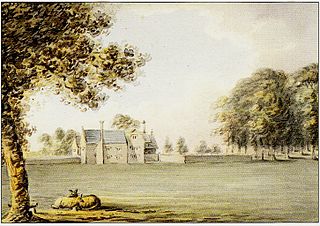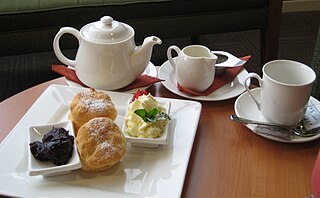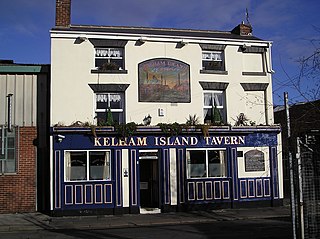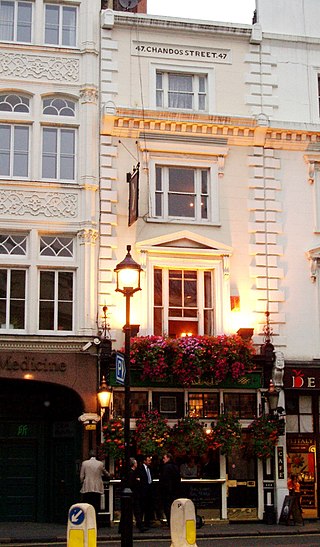
The Campaign for Real Ale (CAMRA) is an independent voluntary consumer organisation headquartered in St Albans, England, which promotes real ale, cider and perry and traditional British pubs and clubs. With just over 150,000 members, it is the largest single-issue consumer group in the UK, and is a founding member of the European Beer Consumers Union (EBCU).

A pub is a drinking establishment licensed to serve alcoholic drinks for consumption on the premises. The term first appeared in the late 17th century, and was used to differentiate private houses from those which were open to the public as alehouses, taverns and inns. Today, there is no strict definition, but CAMRA states a pub has four characteristics:
- is open to the public without membership or residency
- serves draught beer or cider without requiring food be consumed
- has at least one indoor area not laid out for meals
- allows drinks to be bought at a bar
The phrase Uncle Tom Cobley and all is used in British English as a humorous or whimsical way of saying et al., often to express exasperation at the large number of people in a list. The phrase comes from a Devon folk song, "Widecombe Fair", collected around 1890 by Sabine Baring-Gould. Its chorus ends with a long list of people: "Bill Brewer, Jan Stewer, Peter Gurney, Peter Davy, Dan'l Whiddon, Harry Hawke, Old Uncle Tom Cobley and all." The surname is spelt as "Cobleigh" in some references.

Widecombe in the Moor is a village and large civil parish in Dartmoor National Park in Devon, England. Its church is known as the Cathedral of the Moors on account of its tall tower and its size, relative to the small population it serves. It is a favourite tourist centre, partly for its scenic character and partly for its connection to the popular song “Widecombe Fair”.
Widecombe Fair is an annual fair in England, held in the Dartmoor village of Widecombe-in-the-Moor on the second Tuesday of September. It is well known as the subject of the folk song of the same name, featuring Uncle Tom Cobley and his friends.
Beatrice Chase was the pen name for a British writer known during the first half of the 20th century for her Dartmoor-based novels. Her real name was Olive Katharine Parr, and she claimed to be directly descended from William Parr, the brother of Catherine, the sixth wife of Henry VIII.
Janner is an English regional nickname associated with Plymouth both as a noun and as an adjective for the local accent and colloquialisms. In 1987 Cyril Tawney, in his book Grey Funnel Lines, described its meaning as "a person from Devon", deriving from Cousin Jan, but "more particularly in naval circles anyone from the Plymouth area". The term was also used for members of the Devonshire and Dorset Regiment.
Spreyton is a small rural village just north of Dartmoor in Devon, England. Spreyton is famous for its connection to the tale of “Old Uncle Tom Cobley and all” who came from, and is thought to be buried in Spreyton. Some believe that if Uncle Tom Cobley did exist and did travel to Widecombe fair, he would have travelled from Spreyton.
"Widecombe Fair", also called "Tom Pearce", is a Devon folk song about a man called Tom Pearce, whose horse dies after someone borrows it to travel to the fair in Widecombe with his friends. Its chorus ends with a long list of the people travelling to the fair: "Bill Brewer, Jan Stewer, Peter Gurney, Peter Davy, Dan'l Whiddon, Harry Hawke, Old Uncle Tom Cobley and all." Some research suggests that the names originally referred to real people.
The National Pub of the Year is an annual competition held by CAMRA, the winner of which is announced in the February of the year following that in which the competition is run, that finds the best pub in the UK. Established in 1988, the competition helps to highlight quality pubs around the UK that are worth seeking out and visiting. Each year, each local CAMRA branch nominates one pub in their area to be entered. These 200 pubs then go through to the regional competition, which then whittles down to 4 pubs to go to the national final.
Harry Price DSM was an ordinary seaman of the Royal Navy. He became a well travelled figure, producing accounts and drawings of his travels, and publishing his account of the Royal cruise he was part of aboard the temporarily commissioned HMS Ophir in 1901. He served on a number of ships during the First World War, and later took up a number of occupations.

Cowick is a suburb of the City of Exeter in Devon. Historically it was a manor situated in the parish of St Thomas, Exeter, within the hundred of Wonford. It was formerly the site of a Benedictine monastery.

The cuisine of Devon in England has influenced, and been influenced, by other British cuisine.

The Kelham Island Tavern is a public house in Sheffield. It is the only pub to have become the Campaign for Real Ale (CAMRA) National Pub of the Year two years running.

The Luppitt Inn is the only public house at Luppitt, Devon. Located in the front rooms of a farmhouse, the building is constructed from stone, rendered on one side and includes a tiled roof. The main house, still part of a working farm, was built in the early 19th century. The pub entrance is on the north side of the house, leading to a two-roomed pub. The serving room includes a simple counter made of matchboard, and some simple shelves, as well as a few seats, whilst the second room includes a brick fireplace. The toilets are outside, across the yard. The only table in the pub is covered in puzzles. The unique layout has meant that the pub is on the Campaign for Real Ale's National Inventory of Historic Pub Interiors.

The Harp is a public house at 47 Chandos Place, Covent Garden, London, WC2N 4HS.

The Crown & Thistle was a pub at 44 The Terrace, Gravesend, Kent, England.

The Commercial is a public house at 210-212 Railton Road, Herne Hill, London. It is cited in 'The CAMRA Regional Inventory for London' as being one of only 133 pubs in Greater London with a pub interior of special historic interest, most notably for its, "Original counters, bar-back, fireplaces and much fielded wall panelling" dating from the 1930s. In July 2016, Lambeth Council designated The Commercial as a locally-listed heritage asset of architectural or historic interest, being described as a, "Two-storey Neo Georgian style inter-war pub with a three-part convex façade which follows the curve of the building line".










